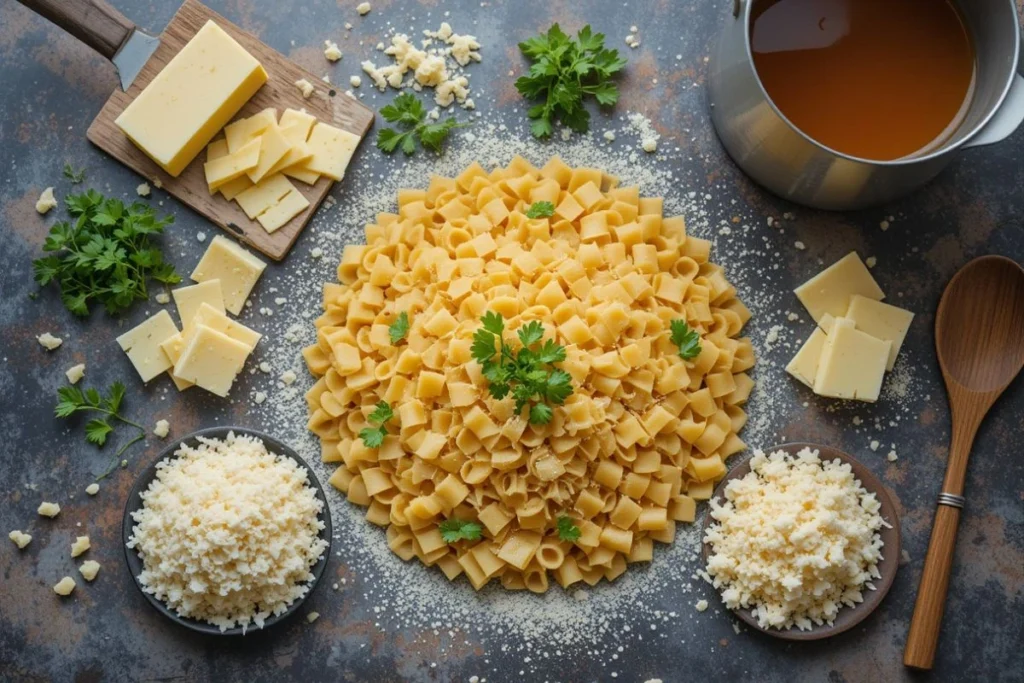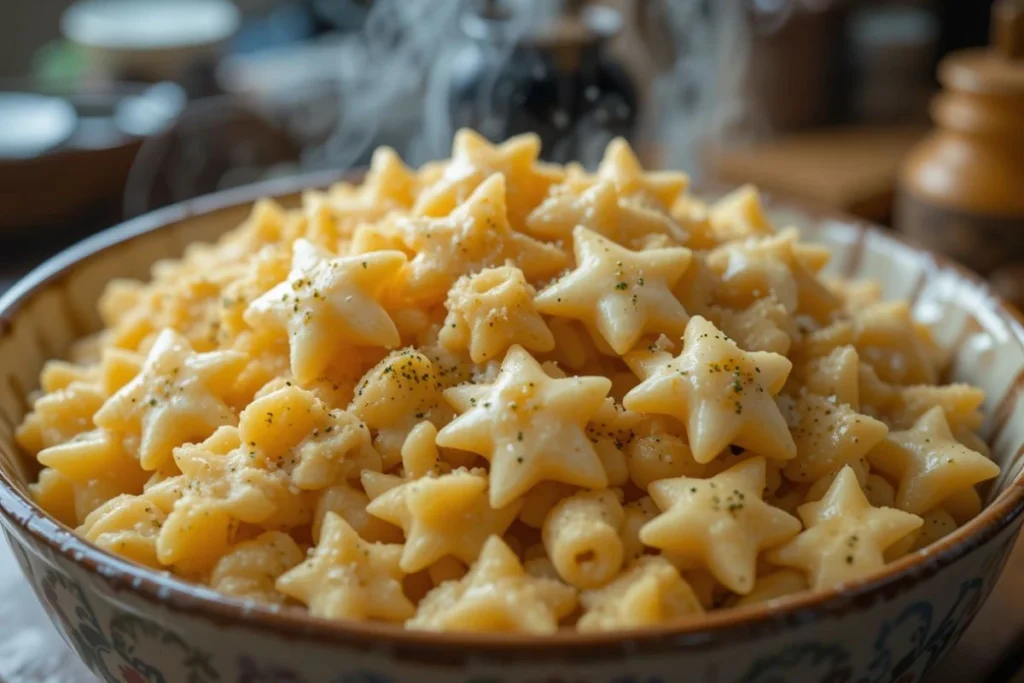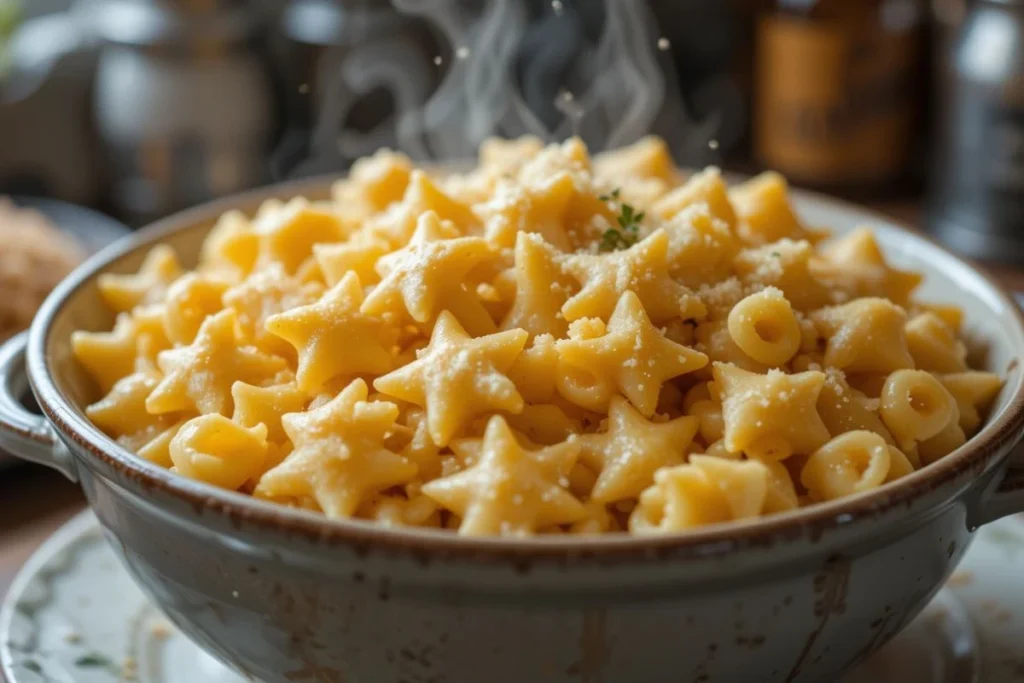Pastina Recipe: The Ultimate Comfort Food Guide
Table of Contents
Introduction to Pastina

What is Pastina?
Pastina is the tiny but mighty pasta that has comfort written all over it. If you’ve never heard of it before, let’s change that! Pastina literally means “little pasta” in Italian. These are the tiniest stars, dots, or shapes you can imagine—small enough to melt in your mouth and soothe your soul. Unlike larger pastas, pastina is often cooked directly in broth or milk, making it creamy and deeply comforting.
In Italy and among Italian-American families, pastina is pure comfort in a bowl. It’s what many people eat when they’re sick, feeling blue, or just need a taste of home. Its delicate texture is easy on the stomach and even easier to fall in love with.
Interestingly, pastina is often the first solid food many Italian babies eat, and it’s a nostalgic dish adults crave years later. It’s one of those meals that’s simple but packed with love and memories. Whether served with just a pat of butter, a sprinkle of Parmesan cheese, or dressed up with an egg and broth, pastina always delivers cozy satisfaction.
History and Origins of Pastina
Pastina’s story begins in the heart of Italy, the birthplace of pasta. Italians have been crafting pasta for centuries, and tiny varieties like pastina evolved naturally. Made traditionally from semolina flour, pastina became an easy way to introduce pasta to babies, the elderly, or anyone needing an easily digestible meal.
Over time, pastina branched into several forms—stelline (tiny stars), acini di pepe (peppercorn-sized beads), and even teeny tiny alphabet shapes for kids. Its presence spread globally as Italians emigrated, bringing their food traditions with them. Pastina’s simplicity made it universal, embraced by cultures worldwide.
Surprisingly, pastina carries a lot of emotional meaning. It’s not just food; it’s history, culture, and comfort on a spoon. Especially in Italian-American households, it represents family traditions passed down through generations, from nonna (grandmother) to grandchild.
Why Pastina is the Perfect Comfort Food
Nutritional Benefits of Pastina
At first glance, pastina might just seem like simple carbs, but it actually carries quite a few benefits, especially when paired with wholesome ingredients. Here’s the scoop:
- Easy Digestion: Its tiny size and soft texture make it incredibly easy for the body to digest.
- Energy Boost: Made mainly from semolina or durum wheat, pastina provides a healthy dose of carbohydrates—your body’s favorite energy source.
- Customizable Nutrition: You can add milk for calcium, eggs for protein, and veggies for fiber and vitamins.
- Gentle on the Stomach: Perfect for those recovering from illness, surgery, or even babies transitioning to solids.
- Low in Fat: Basic pastina is low in fat, making it a guilt-free option when prepared simply.
When you throw in broth, cheese, or veggies, it transforms into a mini nutritional powerhouse. It’s like a blank canvas that you can tailor to your specific dietary needs.
Emotional Connection and Childhood Memories
Ask almost any Italian-American or someone raised in an Italian household about pastina, and chances are you’ll see their face light up with a nostalgic smile. Pastina isn’t just about taste; it’s a warm memory from childhood kitchens, a dish that wraps you in emotional warmth the same way a favorite old blanket does.
It’s what your mom or nonna would whip up when you were under the weather. It’s the taste of lazy Sunday mornings or cozy, rainy days. The smell alone—the combination of butter, broth, and pasta—can transport you right back to sitting at a kitchen table with little legs swinging under your chair.
All around the world, pastina is treasured as the very definition of comfort food, not just in Italian culture. It’s minimalistic but powerful, like a culinary lullaby soothing both body and soul.
Essential Ingredients for Traditional Pastina

Core Ingredients Needed
Before diving into your pot and stirring up some memories, you’ll need a few basics. Here’s what the traditional pastina setup looks like:
- Pastina: About 1/2 cup (stelline or acini di pepe works beautifully).
- Liquid: Water, broth (chicken or vegetable), or milk. Typically about 2 cups.
- Butter: 1–2 tablespoons, for that luxurious, creamy texture.
- Parmesan Cheese: Freshly grated to add a nutty, savory boost.
- Salt: A small pinch to bring out all the flavors.
Simple, right? Yet these ingredients work together to create something magical.
The secret is in the ratios and the care you put into cooking it. Good broth and high-quality Parmesan can take your pastina from basic to mind-blowingly delicious in seconds.
Optional Additions for Flavor
Want to jazz up your pastina a little? Here are a few optional additions that can elevate your dish:
- Egg: Whisk an egg and stir it in during the last minute for a rich, silky texture.
- Herbs: Fresh parsley, basil, or even thyme can add a fresh pop.
- Garlic: Sautéed in butter before adding your liquid can infuse the dish with savory goodness.
- Vegetables: Peas, carrots, or spinach bring color, texture, and extra nutrition.
- Meat: Tiny bits of cooked chicken, turkey, or even sausage can make it heartier.
Think of pastina as your culinary playground. It’s endlessly adaptable, depending on your mood or what’s in your fridge!
Step-by-Step Traditional Pastina Recipe
Preparing Your Ingredients
Preparation is key when it comes to perfect pastina. Here’s a quick checklist:
- Measure Your Ingredients: Precision matters for achieving the perfect texture.
- Choose Your Cooking Liquid: Decide if you want a creamy, milky version or a more savory broth-based dish.
- Prep Optional Add-ins: If you’re adding veggies, herbs, or meat, chop and cook them beforehand.
Getting organized means you won’t overcook the tiny pasta, which can happen very quickly.
Cooking Instructions
Follow these easy steps to make a bowl of the coziest pastina:
- Heat Liquid: Bring your water, broth, or milk to a gentle boil in a small saucepan.
- Add Pastina: Stir in the pastina slowly, lowering the heat to medium.
- Stir Frequently: This pasta cooks FAST—within 4–6 minutes—so keep an eye on it and stir often.
- Check Texture: Pastina should be tender but not mushy.
- Add Butter and Cheese: Stir in butter first, then sprinkle cheese on top. Mix until creamy.
- Taste and Season: Add a little salt if necessary. If you used broth, you might not need much additional seasoning.
Serve hot, ideally in your coziest bowl, with maybe a sprinkle of extra cheese because why not?
Variations of the Classic Pastina

Cheesy Pastina
When you think comfort food, cheese is almost always part of the conversation, right? Cheesy pastina takes the traditional version and cranks the comfort level up to ten. It’s rich, creamy, and packed with flavor, making it a go-to when you’re craving something extra cozy.
Here’s how you do it:
- After your pastina is fully cooked, lower the heat and stir in a good handful of shredded cheese.
- Classic choices include Parmesan, mozzarella, or even a sharp cheddar for a little bite.
- Add a splash of milk or cream to make it extra luscious.
- Stir until every tiny pasta star is coated in melted goodness.
It’s essentially like a lighter, quicker version of mac and cheese — but with pastina, it feels even more tender and nostalgic. Want to elevate it further? Sprinkle a little breadcrumb topping and broil it for a minute until golden and crispy. Absolute heaven.
Pastina with Egg
This version is often lovingly called “Italian Penicillin” for its magical ability to make you feel better instantly. It’s like the Italian grandmother’s answer to chicken soup — simple, nourishing, and soul-restoring.
Making pastina with egg is beautifully simple:
- Cook the pastina almost fully in broth or milk.
- Whisk one egg in a bowl.
- Turn off the heat and slowly drizzle the egg into the hot pastina, stirring vigorously to create silky, delicate egg ribbons.
- Finish with a pat of butter and a generous sprinkle of Parmesan.
It’s like eating a hug. Plus, it adds a protein boost, making it more filling and balanced. Some people also add a dash of black pepper or nutmeg for extra warmth and spice.
Broth-Based Pastina
Sometimes, less is more. Broth-based pastina is perhaps the most traditional and healing way to enjoy this dish. Perfect for when you’re feeling under the weather or just want something light but satisfying.
- Use a high-quality broth — homemade if possible.
- Simmer the pastina right in the broth without draining it afterward.
- Top it off with a light drizzle of olive oil and a dusting of Parmesan cheese.
The pasta soaks up all the flavors of the broth, becoming a delicate, flavorful bite that warms you from the inside out. You can even toss in some finely chopped carrots, celery, or peas if you want a little more texture and nutrition.
Creative Pastina Recipes for Every Taste

Vegetable Pastina
If you want to add a fresh, healthy twist to your pastina, vegetables are the way to go. Vegetable pastina is colorful, nutrient-rich, and a great way to use up whatever veggies you have lying around.
Here’s a quick version:
- Cook your pastina halfway in broth.
- Add finely diced veggies like carrots, zucchini, peas, or spinach to the pot.
- Simmer together until the pastina is tender and the vegetables are soft but still vibrant.
For a burst of flavor, you can add a little garlic sautéed in olive oil, or even a squeeze of lemon at the end. It’s bright, refreshing, and somehow still as comforting as the classic version.
Creamy Garlic Pastina
Calling all garlic lovers! If you crave a bold, savory dish with a rich aroma, creamy garlic pastina is your new best friend.
To make it:
- Sauté the minced garlic in butter until it turns fragrant and golden.
- Add your cooking liquid and bring to a gentle simmer.
- Stir in your pastina and cook until tender.
- Finish with a generous splash of cream or a dollop of cream cheese for extra silkiness.
Toss in a handful of chopped parsley and a few cracks of black pepper, and you have yourself a bowl of sheer joy. The creamy, garlicky flavor profile makes it feel way fancier than it is — but it still comes together in under 15 minutes.
Pastina Soup
Want something even more comforting and hearty? Pastina soup is the answer. It’s basically like chicken noodle soup’s gentler, cuddlier cousin.
Here’s how you can build a basic pastina soup:
- Start with a flavorful broth base (chicken or vegetable).
- Add diced carrots, celery, and onion, and let them simmer until tender.
- Stir in pastina and let it cook in the broth.
- For a protein boost, you can add shredded chicken or turkey.
- Season with fresh herbs like thyme and parsley.
This soup is perfect for chilly nights, sick days, or any time you want something nurturing and light.
Tips for Making the Perfect Pastina
Choosing the Right Pasta
Not all tiny pasta is created equal. While “pastina” technically refers to any very small pasta shape, there are specific kinds that shine best in classic recipes:
- Stelline: Little stars, perfect for soup or creamy dishes.
- Acini di Pepe: Tiny bead-shaped pasta, ideal for broth-based pastina.
- Orzo: Rice-shaped pasta, a great substitute if you can’t find traditional pastina.
When shopping, look for authentic Italian brands — they tend to hold their texture better and cook up more evenly. If you’re aiming for that nostalgic, melt-in-your-mouth experience, stick with traditional wheat pastina.
Cooking Tips and Tricks
Pastina is super easy to cook — but it’s just as easy to mess up if you’re not careful. Here are a few pro tips:
- Stir Constantly: Pastina tends to stick to the bottom of the pan if you leave it alone.
- Use Enough Liquid: Pastina absorbs a lot, so don’t skimp on the broth or milk.
- Cook Gently: A rolling boil can overcook the tiny pasta and turn it to mush.
- Finish Off-Heat: If you want a creamier texture, turn off the heat when it’s just shy of done, then let it sit for a minute or two.
Pastina cooks so fast that you literally have to babysit it — but it’s worth every second for that perfect texture.
Common Mistakes to Avoid
Overcooking the Pastina
This is the biggest pitfall when making pastina — and trust me, it happens faster than you’d think. Because pastina is so small and delicate, it only takes about 4–6 minutes to cook to perfection. Go even a minute over, and you’re dealing with a gummy, sticky mess instead of the silky, comforting dish you were aiming for.
To avoid this:
- Keep a close eye on the clock and start tasting for doneness around the 4-minute mark.
- Keep stirring often to avoid sticking and to cook everything evenly
- Turn off the heat as soon as it’s tender — the residual heat will finish the job.
Think of pastina like gold: precious, delicate, and needing your full attention for just a few minutes to shine.
Using Too Much or Too Little Liquid
Getting the liquid ratio wrong can wreck your pastina dish. Too much liquid? It becomes soup (unless you want soup, of course!). Too little liquid? The pasta clumps together into an unpleasant, sticky ball.
Here’s the sweet spot:
- 2 cups of liquid for every 1/2 cup of pastina is a safe bet if you’re aiming for creamy but spoonable consistency.
- If you’re making a broth-based soup, use more liquid — around 3 cups for the same amount of pasta.
And remember, don’t drain the pastina like regular pasta. You want it to soak up the flavor-packed broth or milk for maximum comfort.
How to Store and Reheat Pastina
Best Storage Methods
If you manage to have leftovers (not likely, but still), storing pastina properly ensures it stays delicious:
- Cool it quickly: Spread it out in a shallow container to cool rapidly and prevent overcooking from residual heat.
- Refrigerate in an airtight container: It will stay good for up to 3 days.
- Add a splash of liquid: When storing, a little broth or milk will help prevent the pasta from drying out too much.
Avoid letting pastina sit out at room temperature too long — it tends to get clumpy and lose its velvety texture.
Reheating Without Losing Texture
Reheating pastina can be tricky since it soaks up any leftover moisture. Here’s how to keep it creamy:
- Add Liquid: Splash some broth, milk, or even water into the pastina before reheating.
- Heat Gently: Use a saucepan over low heat, stirring often. Avoid microwaving if possible because it can unevenly dry out the pasta.
- Freshen Up: Stir in a little fresh butter or cheese just before serving to revive its luscious texture.
Properly reheated pastina can taste almost as good as when you first made it — maybe even better because the flavors have had more time to meld.
Pastina for Kids and Babies
Why It’s a Favorite First Food
Pastina is cherished in many families as the very first pasta for little ones. And it’s no wonder why:
- Tiny size: Perfect for little mouths and beginner eaters.
- Soft texture: Easy to gum and swallow, even without many teeth.
- Neutral taste: Mild enough to not overwhelm delicate palates.
- Customizable: Mix it with breastmilk, formula, pureed veggies, or broth to suit any stage of baby food development.
Beyond its practicality, there’s something so sweetly symbolic about starting a child’s culinary journey with a dish that’s so connected to love and tradition.
Safe Preparation Tips
When making pastina for infants or toddlers, safety and simplicity are key:
- Cook it until very soft: A little softer than you would for adults.
- Avoid heavy seasoning: Skip salt, strong spices, and large amounts of cheese for very young babies.
- Mash if necessary: For early eaters, you can mash the cooked pastina with a fork for an easier texture.
- Monitor temperature: Make sure it’s lukewarm, not hot, before serving.
As your child grows, you can gradually introduce more flavors, textures, and fun additions like tiny veggie pieces or a sprinkle of mild cheese.
Serving Suggestions and Pairings
Best Side Dishes
While pastina can totally shine solo, pairing it with a few simple sides can round out a beautiful, cozy meal:
- Simple Salads: A crisp green salad with lemon vinaigrette balances the richness.
- Roasted Vegetables: Try asparagus, carrots, or Brussels sprouts roasted to caramelized perfection.
- Grilled Chicken: Lightly seasoned chicken breasts or thighs make a wholesome, satisfying plate.
- Garlic Bread: Because carbs-on-carbs is never a bad idea when comfort food is the goal.
Pairing pastina with vibrant veggies or protein transforms it from a humble bowl to a complete, satisfying dinner.
Drinks That Complement Pastina
You might not think much about drink pairings for a simple pasta dish, but the right beverage can definitely enhance the experience:
- White Wine: A crisp Pinot Grigio or Sauvignon Blanc if you’re feeling fancy.
- Sparkling Water: A clean, bubbly palate cleanser.
- Light Beer: Something like a pilsner pairs beautifully with creamy, cheesy pastina.
- Herbal Tea: Especially if you’re under the weather, chamomile or mint tea makes a soothing pairing.
If you’re serving pastina to kids, a glass of cold milk or diluted fruit juice makes for the perfect pairing.
Healthier Alternatives to Traditional Pastina
Whole Wheat and Gluten-Free Options
Pastina is delicious in its classic form, but if you’re looking for a healthier or more diet-conscious option, don’t worry — you’ve got choices.
- Whole Wheat Pastina: Made from whole durum wheat flour, it has more fiber, vitamins, and minerals compared to regular pastina. It has a slightly nuttier taste but still delivers that soft, cozy texture.
- Gluten-Free Pastina: With more people sensitive to gluten these days, several brands now offer gluten-free tiny pasta made from rice flour, corn flour, or even quinoa. These versions cook similarly but may require a bit more stirring to avoid clumping.
Switching to a whole-grain or gluten-free pastina means you can still indulge in your favorite comfort food while being a little kinder to your body.
Adding Superfoods to Your Pastina
Want to supercharge your pastina into a powerhouse of nutrients? It’s super easy.
- Spinach: Add a handful of baby spinach at the end for a boost of iron and vitamins A and C.
- Kale: Chop it finely and stir it into your broth for a fiber boost.
- Chia Seeds: Stir in a teaspoon right before serving for extra Omega-3 fatty acids.
- Turmeric: Add a pinch for its anti-inflammatory properties — plus a beautiful golden color.
These little upgrades can turn your nostalgic bowl of pastina into something that’s just as nourishing as it is comforting. You don’t have to change the heart of the dish; just enhance it!
Frequently Asked Questions About Pastina
Can I Make Pastina Ahead of Time?
You can — but it’s best fresh. Pastina soaks up liquid fast and thickens as it rests. If you plan to make it ahead:
- Cook it slightly underdone.
- Store it with extra broth or milk.
- Warm it slowly with a splash of liquid to bring back its creamy texture.
Perfect for meal prepping quick lunches or easy weeknight dinners!
Can You Freeze Cooked Pastina?
Technically, yes, but it’s not ideal. Freezing cooked pastina can cause it to become mushy once thawed because the pasta absorbs more liquid and breaks down.
If you really need to freeze it:
- Cool it completely.
- Store in small, airtight containers.
- Reheat with plenty of broth or milk to bring it back to life.
Better yet, freeze uncooked pastina and simply cook a fresh batch when you need that cozy bowl of goodness.
Conclusion
Pastina is the kind of dish that transcends food — it’s a warm memory, a gentle hug, and a soothing remedy all rolled into one tiny bowl. From its ancient Italian roots to your own kitchen, pastina has proven itself to be a timeless comfort food.
Whether you prefer the traditional buttery version, a broth-based bowl, or creative twists with vegetables and cheese, pastina offers infinite possibilities. It’s the ideal dish for kids, grown-ups, and anyone who needs a little extra love on their plate.
Next time you’re feeling nostalgic, tired, or simply hungry for something soulful and satisfying, whip up a pot of pastina. Believe me — both your heart and your stomach will be grateful.

